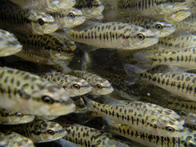Guadalupe Bass – A Conservation Success Story
By Tim Birdsong, Chief of Habitat Conservation, Inland Fisheries – Texas Parks & Wildlife
from The Fishing Wire

The official state fish, Guadalupe Bass, has been restored to the South Llano River. Guadalupe Bass are endemic to the South Llano River and other clear, spring-fed rivers of the Texas Hill Country. They are threatened by loss of habitat and hybridization with non-native, introduced Smallmouth Bass that are native to the Great Lakes of North America and portions of the Ohio, Tennessee, upper Mississippi, and Saint Lawrence rivers. Smallmouth Bass have been introduced throughout North America, Africa, and Eurasia to enhance sport fishing opportunities.
This conservation success story for Guadalupe Bass begins with an ill-fated, experimental introduction of Smallmouth Bass to the South Llano River in 1958-1960. The introduction proved unsuccessful in establishing a self-sustaining Smallmouth Bass fishery, but resulted in an unforeseen and unintended consequence of creating a hybrid population of Guadalupe Bass and Smallmouth Bass. This hybridization went unnoticed in the South Llano River until similar situations resulted from stocking of Smallmouth Bass in other Hill Country rivers.
In 1974-1980, Smallmouth Bass were stocked by Texas Parks and Wildlife Department (TPWD) in the Blanco, Guadalupe, Medina and San Gabriel rivers, and in Cibolo and Onion creeks. Once hybridization was detected and threats to Guadalupe Bass were recognized, TPWD ceased efforts to establish Smallmouth Bass fisheries in Hill Country Rivers and instead began to devise a strategy to prevent the local extirpation and possible extinction of Guadalupe Bass. Initial conservation efforts included establishment of a refuge population of genetically-pure Guadalupe Bass in the Sabinal River in 1988. In 1992, TPWD initiated a Guadalupe Bass hatchery program that has since produced and stocked 2,355,807 Guadalupe Bass in Hill Country Rivers. TPWD also partnered with local landowners, non-governmental organizations, fishing clubs, river authorities, and other partners to restore and preserve habitat conditions for Guadalupe Bass in rivers throughout the Hill Country.
In 2010, TPWD focused its attention on the South Llano River and the hybrid population that resulted from the historic Smallmouth Bass introduction. In partnership with numerous local cooperators, a plan was hatched to restore Guadalupe Bass to the South Llano River. Between spring 2011 and spring 2017, more than 700,000 genetically-pure Guadalupe Bass were stocked in the South Llano River. Today, less than 2 percent of the Guadalupe Bass population now consists of hybrids.
In addition to the South Llano River stocking program, project cooperators organized river conservation workshops attended by approximately 750 landowners and local community partners in the watershed. Over 78,000 acres of ranchlands implemented stewardship practices to help preserve fish habitats. Restoration projects in the watershed restored 7,754 acres of spring, stream and riparian habitats, directly benefiting water quality and habitat conditions for Guadalupe Bass. These and other conservation efforts in the South Llano River watershed have successfully restored Guadalupe Bass populations and helped promote local stewardship practices that will ensure the river is able to sustain Guadalupe Bass populations into the future. Learn more about efforts to conserve Guadalupe Bass in the South Llano River or watch this video produced by TPWD a few years ago featuring former TPWD Angler Education Instructors Guy Harrison and Mike Andrews.